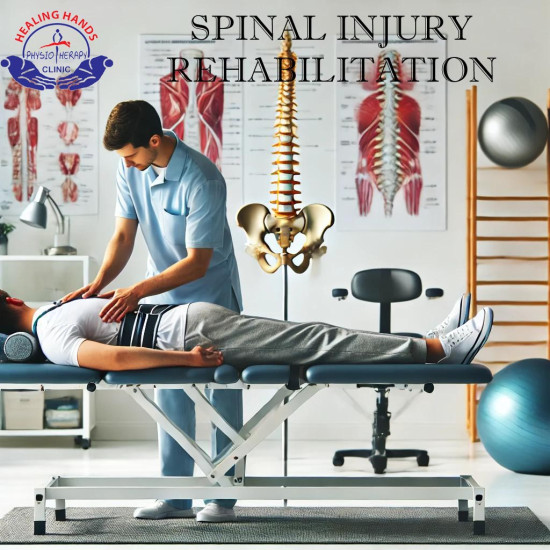Spinal Injury Rehabilitation

- Stock: 1000
- Model: 2412
Spinal Injury Rehabilitation is a recovery process for individuals who have suffered
damage to their spinal cord, whether through a traumatic event (like an
accident) or a non-traumatic cause (such as a disease). This type of injury can
affect movement, sensation, breathing, bladder and bowel control, and even
blood pressure and temperature regulation. Rehabilitation, including
physiotherapy, plays a crucial role in helping patients regain or improve their
abilities after such an injury. The recovery process can be long and depends on
the severity and type of spinal cord injury.
Types
of Spinal Cord Injuries
Complete Spinal Cord Injuries:
This is the most severe type of spinal injury. It occurs when the spinal cord
is fully damaged, cutting off the brain’s ability to send signals below the
injury. This can result in paralysis. For example, an injury at the lumbar
level may cause paralysis below the waist, while an injury at the cervical
level could result in loss of movement in both the lower and upper body.
Incomplete Spinal Cord Injuries:
In this type of injury, the spinal cord is only partially damaged. This means
that some signals can still pass between the brain and the body below the
injury. The effects of incomplete injuries can vary greatly among individuals;
some might have slight impairments, while others might experience significant
loss of function.
Goals
of Spinal Injury Rehabilitation
The main goals of spinal injury
rehabilitation are:
- Maximizing recovery of movement
and sensation.
- Preventing secondary health issues
and complications.
- Improving independence in daily
activities such as eating, bathing, and mobility.
- Helping individuals live as fully
as possible despite their injury.
How
Does Spinal Injury Rehabilitation Work?
Rehabilitation depends on the level and
type of spinal cord injury. It often starts in an intensive care unit and
continues through various phases:
- Acute Phase: Initial treatment and
stabilization.
- Sub-Acute Phase: Focuses on preventing
complications and promoting recovery.
- Chronic Phase: Long-term strategies to maintain
and improve function.
The rehabilitation process can last
several weeks to months, and ongoing follow-up is often required. The
physiotherapist will assess the patient’s condition, set goals, identify key
challenges, and design a treatment plan that may include pain management,
exercises to improve motor skills, and strategies to enhance mobility and
overall health.
Benefits
of Physiotherapy in Spinal Injury Rehabilitation
Physiotherapy is essential in spinal
injury rehabilitation, offering numerous benefits:
- Pain Control: Helps reduce or eliminate pain
through exercises, manual therapies, and advice on posture and movement.
- Movement Awareness: Enhances movement by teaching
proper posture and reducing stress on the back.
- Increase Functional Strength: Strengthens muscles that may have
weakened due to the injury.
- Balance and Coordination: Improves these skills, which can
be affected by spinal injuries.
- Cardiovascular Strength: Maintains heart health through
aerobic exercises, aiding recovery.
- Respiratory Muscle Strength: Especially important for those
with injuries to the cervical or thoracic spine, helping to improve
breathing.
- Improved Mobility: Helps patients regain mobility
through exercises, assistive devices, and techniques to prevent scar
tissue formation.
Physiotherapy
Interventions Used in Treatment
Physiotherapists use various
interventions to help spinal injury patients recover, including:
- Thermotherapy (heat treatment)
- Transcutaneous Electrical Nerve
Stimulation (TENS)
- Functional Electrical Stimulation
(FES)
- Acupuncture
- Breathing exercises
- Massage therapy
- Strengthening exercises
- Stretching exercises
Who
Can Benefit from Spinal Injury Rehabilitation?
Spinal injury rehabilitation is
beneficial for patients with:
- Spinal cord injuries (traumatic
and non-traumatic)
- Neuromuscular disorders or central
nervous system conditions
- Diseases affecting the spinal cord
- Dual diagnoses involving both
spinal cord and brain injuries
- Post-spinal surgery recovery
Rehabilitation helps these individuals regain
control over their body functions and improve their quality of life.
Unlimited Blocks, Tabs or Accordions with any HTML content can be assigned to any individual product or to certain groups of products, like entire categories, brands, products with specific options, attributes, price range, etc. You can indicate any criteria via the advanced product assignment mechanism and only those products matching your criteria will display the modules.
Also, any module can be selectively activated per device (desktop/tablet/phone), customer login status and other criteria. Imagine the possibilities.







